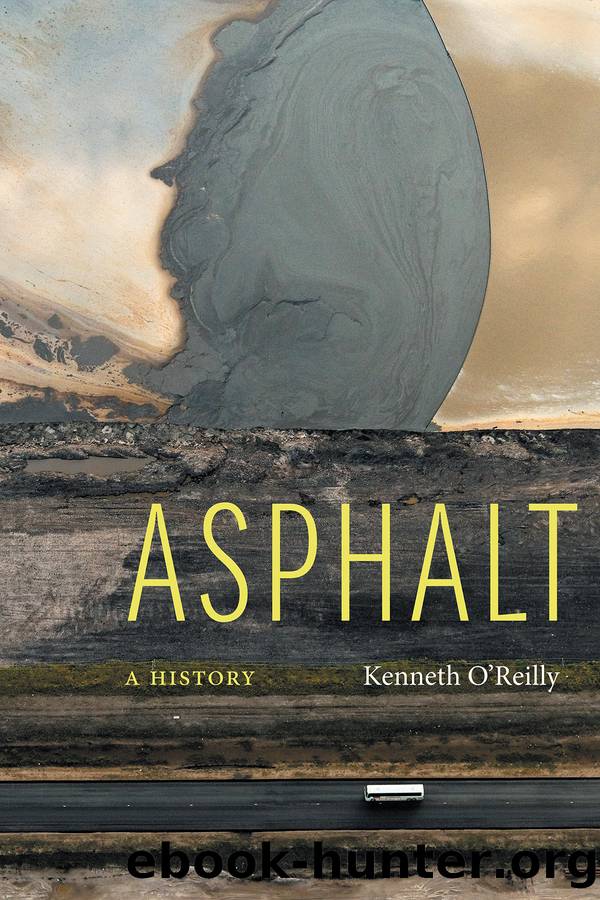Asphalt by Kenneth O'Reilly;

Author:Kenneth O'Reilly; [O'Reilly, Kenneth]
Language: eng
Format: epub
Tags: NAT038000 Nature / Natural Resources, BUS032000 Business & Economics / Infrastructure, HIS037000 History / World
Publisher: University of Nebraska Press
8
Overburden
The Oil-Sand Century
On March 24, 1989, the oil tanker Exxon Valdez struck Bligh Reef in Alaskaâs Prince William Sound, spilling at least eleven million gallons and fouling 11,000 square miles of seawater and 1,300 miles of shoreline. VECO, the primary cleanup contractor, purchased 530 miles of toilet paper (âif unrolledâ) for the labor force.1 With such other helpers as one thousand U.S. military personnel, Exxon burned the spilled oil and attacked it with dispersants, high-pressure hoses, and manual labor. Having scrubbed oil from sea otters and rocks, many cleanup workers developed health problems. Other spill-associated damage cascaded through native villages and fisheries.
The Exxon Valdez skipper, Joseph Hazelwood, had a backstory of asphalt and alcohol. An excellent sailor when sober, he once saved the Exxon Chester, an asphalt tanker caught in a severe storm while heading down the East Coast. When the Exxon Valdez met Bligh Reef, Hazelwood was not on the bridge, having turned piloting over to his third mate (who lacked a piloting license). Given a blood-alcohol level of 0.061 percent ten hours after the collision, Hazelwoodâs lawyers said he began drinking in his cabin because he knew that his career was over. Two days before the spillâs first anniversary, an Anchorage jury found Hazelwood not guilty of three felony charges, including operating a vessel while under the influence of alcohol. The jury found him guilty of negligent discharge of oil, a misdemeanor. In 1992 an Alaska court vacated the conviction because the Clean Water Act of 1972 granted immunity to anyone who reported a spill, and Hazelwood had done so. Exxon succeeded in reducing a jury award in a civil lawsuit from $5 billion to $500 million. The company settled a federal lawsuit for $900 million.
The Exxon Valdez cleanup recovered no more than 10 percent of the spilled oil. Some of the remaining oil lost its lighter fractions over time, leaving behind a substance as close to asphalt as anything else. The Exxon Valdez Oil Spill Trustee Council calculated a ten-acre spread of oil âremain[ing] in surface sediments . . . primarily in the form of highly weathered, asphalt-like or tar deposits.â Oil remained in acreage beyond those ten, trapped in âsubsurface, intertidal areas . . . not easily exposed to natural weathering processes.â In 2014, two years after the Oriental Nicely (née Exxon Valdez) beached for dismantling in India, the Trustee Council said that â200 tons of oil might still existâ in Prince William Sound. That oil will degrade at a âvery slowâ rate and someday leave behind no trace beyond asphalt.2
Download
This site does not store any files on its server. We only index and link to content provided by other sites. Please contact the content providers to delete copyright contents if any and email us, we'll remove relevant links or contents immediately.
| General | Cities |
| National Parks | Provinces |
Canadians by Roy MacGregor(1155)
Chris Chelios by Chris Chelios(1051)
109 Walks in British Columbia's Lower Mainland by Mary Macaree(1009)
Stone by Stone by Liz Bryan(958)
Berlin Travel Guide by Lonely Planet(917)
I Hear She's a Real Bitch by Jen Agg(905)
Germany Travel Guide by Lonely Planet(894)
Liquor, Lust and the Law by Aaron Chapman(888)
From the Tundra to the Trenches by Eddy Weetaltuk(881)
Moon Atlantic Canada by Andrew Hempstead(838)
105 Hikes in and Around Southwestern British Columbia by Stephen Hui(835)
The Prince by unknow(832)
1,000 Places to See in the United States & Canada Before You Die by Patricia Schultz(826)
Uncle John's Bathroom Reader Plunges into Canada by Bathroom Readers' Institute(825)
Wine by Rod Phillips(816)
DK Eyewitness Top 10 Travel Guides Montreal & Quebec City by DK(798)
How to Move to Canada by Terese Loeb Kreuzer Carol Bennett(787)
Hidden Ontario by Terry Boyle(778)
50 Best Girlfriends Getaways in North America by Marybeth Bond(777)
